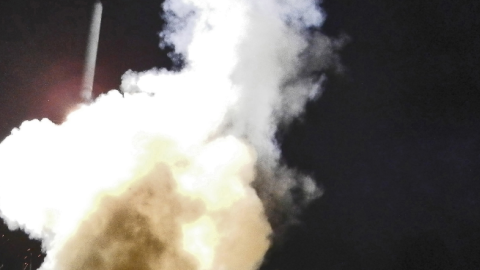When looking for new employment it is wise not to leave one job before finding a new one. The advice applies elsewhere: security is too valuable to be vacated in favor of hope. The Department of Defense disagrees with this common sense. The budget that Secretary of Defense Chuck Hagel presented in March will end the purchase of Tomahawk Land Attack (TLAM) cruise missiles in 2016 without a replacement in clear sight.
The TLAM joined the U.S. fleet during Ronald Reagan’s first term. The missile is a particularly effective instrument in the U.S. arsenal because naval vessels can launch it either surreptitiously—from submarines—or from surface ships both of which can strike independently of bases or diplomatic entanglement. A TLAM can carry a one thousand-pound warhead more than one thousand miles, as it did when NATO used force to end Serb leader Slobodan Milosevic’s massacres of the Kosovar Albanians in 1999. The missile’s accuracy and explosive power are exemplified by its utter destruction of the Serbian defense ministry, which a barrage of TLAMs reduced to rubble in downtown Belgrade while immediately adjacent large buildings survived wholly unscathed.
Other examples of the TLAM’s usefulness as a ship-launched weapon include submarine and surface ship-launched strikes during the 1991 Gulf War fought to evict Iraqi occupiers from Kuwait. The missile was used with great effect in the 2003 Gulf War. Most recently President Obama ordered the use of TLAMs against Muammar Qaddafi in 2011.
With existing technology the missile can be given the guidance to carry out a mission in an hour. And, unlike the earliest versions, the TLAM can circle awaiting instructions that might change targets after launch. Its accuracy is as fearsome as its ability to diminish the risk to manned aircraft is beneficent.
Today, the U.S. maintains a stockpile of TLAMs but the Navy’s now-shelved plan to purchase nearly 1,000 new TLAMs shows both its continued usefulness and the ageing stockpile of TLAMs that were built and delivered years ago.
But the search for cost savings at the Defense Department appears to have triumphed over common sense. A Navy spokesperson announced that the current version of the Tomahawk “exceeds combat requirements.” This may be true. But, then, why does the budget provide funding for a Next Generation Land Attack Weapon “to support an improved strike capability with an initial operational capability no later than 2024?” If the current missile is more than what’s needed, why build one with greater capability?
And what happens if unanticipated events deplete current reserves of naval-delivered cruise missile before a new one is ready? The answer is that the U.S. will be in the same position as the job-seeker who has left one position before finding employment elsewhere.
The age of a weapon, especially one that has been continually modernized, does not prove the need for a replacement. In his History of the English Speaking Peoples, Winston Churchill, speaking of the long bow writes that: “For the first time Infantry possessed a weapon which could penetrate the armor of the clanking age, and which in range and rate of fire, was superior to any method ever used before or ever used again, until the coming of the modern rifle. The War Office has among its records a treatise written during the peace after Waterloo be a General Officer of long experience in the Napoleonic wars, recommending that muskets should be discarded in favor of the Long Bow on account of its superior accuracy, rapid discharge and effective range.”
The general Churchill quotes may have been speaking elliptically and in protest of the musket’s unreliability. But the broad point about the sufficiency of proven technology is solid. It applies especially to our own predicament. With Iran’s increasingly likely arrival as a nuclear power proliferation in the Mideast is predictable; terrorism is flourishing; and there is good reason to doubt the administration’s notion that conventional war is a holdover from a bygone age. Look at Crimea. In fact, the international neighborhood is becoming more dangerous at the same moment that the U.S. is accelerating the shrinking of its military.
After the Gulf War, then-Secretary of Defense Cheney thanked his predecessors for their efforts to restore the U.S. military which bore fruit in that unexpected war. Future senior U.S. officials are unlikely to hold the same opinion of their immediate predecessors whose successive budgets will cut one $1 trillion from U.S. defenses, of which the Tomahawk missile cancellation is a small, but vital part.
















